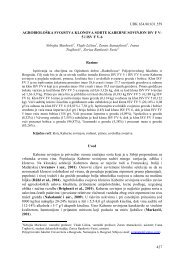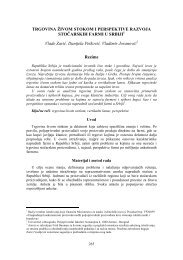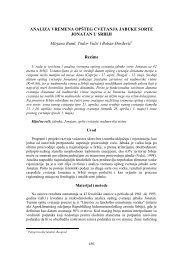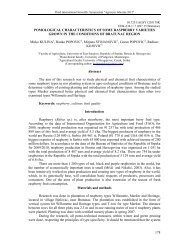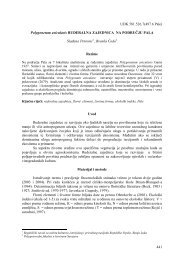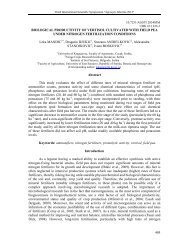746 Vilmos KOVAC, Hajnalka KOVAC-SARKANJ, Branislav ...
746 Vilmos KOVAC, Hajnalka KOVAC-SARKANJ, Branislav ...
746 Vilmos KOVAC, Hajnalka KOVAC-SARKANJ, Branislav ...
You also want an ePaper? Increase the reach of your titles
YUMPU automatically turns print PDFs into web optimized ePapers that Google loves.
Third International Scientific Symposium "Agrosym Jahorina 2012"<br />
10.7251/AGSY1203<strong>746</strong>K<br />
UDK 631.11:338.43.02<br />
POSSIBLE ANSWERS TO THE NEW CHALLENGES OF THE AGRICULTURAL<br />
PRODUCTION TOWARD RURAL DEVELOPMENT AND AGRO-ECONOMIC<br />
EFFICIENCY<br />
<strong>Vilmos</strong> <strong>KOVAC</strong>, <strong>Hajnalka</strong> <strong>KOVAC</strong>-<strong>SARKANJ</strong>, <strong>Branislav</strong> RAKETIC<br />
Corvinus University of Budapest, Faculty of horticultural science Consultation centre in Senta,<br />
doo “Quality consulting”, Serbia<br />
(Corresponding author: haccp1@gmail.com<br />
Abstract<br />
Agricultural producers primarily have to respect the principles of the safety of food<br />
and traceability of the product, considering purpose and place of consumption of the<br />
agricultural products. They also have to pay attention on the regulations according to the<br />
marking and packaging the products. To demonstrate the product compliance it has to be used<br />
a principle of a production system, like GLOBALG.A.P, organic production, integrated<br />
production, marking the products with mark on geographic origin etc.<br />
Keywords: standards, regulations, rural development<br />
Introduction<br />
Information technology development and more efficient transportation are lead to the<br />
world globalization. This makes impact to the primary agricultural production too. In this<br />
changed environment the food market becomes more and more concurrent, but the<br />
agricultural actors who have not got huge surfaces of agricultural lands but they are in the<br />
rural environment must to be found their place. The productions on these small parcels have<br />
to be specific and recognizable.<br />
In order to be the production economically justified and by that reason to be attractive<br />
for younger generations too, agricultural producers have to be chosen new methods and<br />
techniques of production. The new generation of farmers has to be well educated, to be<br />
familiar with the newest law regulations, standards, and methods of production as well as to<br />
be prepared for the most up to date marketing techniques in order to recognize the newest<br />
requirements of the customers.<br />
Basically, all agricultural actors must to be respected the law defined requirements.<br />
They are obliged to respect the requirements of the agricultural and food production,<br />
among others, it is primarily refers to the environment protection, animal welfare as well as<br />
careful usage of the pesticides and veterinary medicines.<br />
Besides these basic requirements, food producers have to use additional knowledge<br />
and imagination in order to provide value-added products, like products with geographical<br />
indication geographic origin mark, to be provided food by the method organic production,<br />
integrated production, as well as they harmonize their products with the certain standards like<br />
GlobalGAP or with the other requirements of the huge department store chains, to provide<br />
products with individual quality which would be appreciated both by consumers and by<br />
customers (distributors, wholesale and retailers).<br />
<strong>746</strong>
Third International Scientific Symposium "Agrosym Jahorina 2012"<br />
Material and method<br />
When it comes to agricultural production there is a basic requirement that the<br />
agricultural products must to be health safe. Health safety means that the food (product) does<br />
not harm the consumers’ health, so “the food is not safe, if it is harmful for the human health<br />
and if it is not suitable for human consumption.”(Zakon o bezbednosti hrane)<br />
In the European regulations num. 178/2002/EC which have been accepted in January<br />
28 th 2002 from the side of the European Parliament and Council defined the general principles<br />
and terms of law concerning to the food, the procedures which are arranged the domain of<br />
food safety and founded by the European organ for food safety.<br />
“Regulation on the basic principles of foodstuff safety stated the followings:<br />
• Comprehensive, unified approach,<br />
• Responsibility for food safety,<br />
• Traceability,<br />
• Consistency, efficiency, dynamism and transparency,<br />
• Risk analysis ,<br />
• Principle precautions (SOMOGYI Á. et al., 2003)<br />
Besides this it would regulate obligations prior to its import into the territory of<br />
European Union, that is the imported food for the sake of sale in the territory of European<br />
Union, must to meet the requirements of the food safety (except some defined exceptions)<br />
because in that way is possible the free movement of products.<br />
Food and feed imported into the Community for placing on the market within the<br />
Community shall comply with the relevant requirements of food law or conditions recognized<br />
by the Community to be at least equivalent there to or, where a specific agreement exists<br />
between the Community and the exporting country, with requirements contained therein.<br />
Although “the state is responsible for the public health of its citizens, but this<br />
responsibility in the given situation does not manifest in the creation and maintenance of<br />
regulations concerning to the food safety, neither in the controlling of the compliance (and<br />
sometimes in forceful implementation) of these regulations (NAGY A. et al, 2003)<br />
To that end on the state level, and from the customers side “increasingly focuses on<br />
the united, integrated approach of chain feeding from the fields to the table. (BÁNÁTI D. et<br />
al, 2003)<br />
Concerning to the creation of the more effective consumer protection against diseases<br />
and to connect work of inspections in the European Community members, regulation num.<br />
178/2002/EC founded a rapid alert system (RASFF, Rapid Alert System for Food and Feed)<br />
which can be displayed the danger that could come from food or feed and which could be<br />
directly or indirectly threaten the human health condition. There is an opportunity for not<br />
European Community members to engage to this rapid alert system.<br />
To enable it to perform its task of monitoring the health and nutritional risks of foods<br />
as effectively as possible, the Authority shall be the recipient of any messages forwarded via<br />
the rapid alert system. It shall analyze the content of such messages with a view to providing<br />
the Commission and the Member States with any information required for the purposes of risk<br />
analysis.<br />
Owing to this system and the notification of the consumers concerning to the problems related<br />
to food safety, consumers and customers pay more attention on food safety. Because of that in<br />
the production of the agricultural products, farmers in all cases have to pay attention that their<br />
products can be used:<br />
• For animal feeding (entering in food chain)<br />
747
Third International Scientific Symposium "Agrosym Jahorina 2012"<br />
• Directly (without any processing, directly consumed food), or like<br />
• Raw material for food industry<br />
It can be sold in domestic or foreign markets. Producers prior to export their products<br />
have to be informed and pay attention on the law regulations of that country where they are<br />
going to sale their products. Pay special attention on the regulations related to the marking and<br />
packaging the products.<br />
Besides excellent knowledge of the agricultural products, they have to be so-called<br />
“managers” in order to recognize and react on requirements of consumers and customers, to<br />
produce quality products in accordance with the Good Agricultural practice.<br />
In the dependence of the purpose of the product, requirements of consumers or<br />
customers agricultural producers voluntary or on the account of customers implement a<br />
system, standard or produce method.<br />
The most basic requirement is when the customer looking for from the agricultural<br />
producer plant treatment diary. The products with the purpose to serve as animal food the<br />
most common is that the customers require only the completed plant treatment diary.<br />
If the fruits or vegetables directly, without processing in the fresh state comes to the<br />
consumers some of them request from customers that the production let to be provided by the<br />
methods of integrated production or they can be requested for GLOBALG.A.P. certificate.<br />
Certificate of GLOBALG.A.P. standard might be carrying out from January 1 st 2012<br />
by the new 4 th version. Every producer has to be registered in the– da GLOBALG.A.P.<br />
database. At this registration every agricultural producer get an unique so-called GGN number<br />
(GLOBALG.A.P. number). “This digit number is unique and remains valid and attached to<br />
the legal entity as long as it exists. It serves as search key on the GLOBAL.A.P. website to<br />
validate certificates.<br />
For the sake of that the customers and consumers could be verified whether the<br />
producer possess valid GLOBALGAP certificate on the base of GGN number, the producer<br />
must to mark the unique GGN number on the packaging. They can mark that number on<br />
products which are produced under the conditions of the GLOBALG.A.P. regulations.<br />
Before the procedure GLOBALG.A.P. certification the agricultural producers must to<br />
state according to whether they provide so-called parallel producing – whether they have got<br />
agricultural producing of products of the other domain which are not covered by the<br />
GLOBALG.A.P. regulations.<br />
This is a cardinal importance, because the products which are derived also have to be<br />
marked at handling and storage, in order to not to be in some way mixed with the products<br />
produced by the GLOBALG.A.P. principles.<br />
By the possessing of the GLOBALG.A.P. standard the agricultural producers can be<br />
demonstrated for the customers and consumers product compatibility from the aspect of food<br />
safety, that the production is carrying out in that way, which would pay attention on the health<br />
protection of the employees as well as on environment protection.<br />
GLOBALG.A.P. certification might be completed separately, this is so-called Option<br />
1 or in groups, this is so-called Option 2. The GLOBALG.A.P. certificates issue for a year<br />
period with that the certification body which have issued the certificates at Option 2 have the<br />
rights on extraordinary control, which would be reported 48 hours earlier to the arrival on site<br />
in the organization as well as at producer.<br />
If the fruits, vegetables or cereal purposed for processing, when entering (or maybe<br />
before it) into the manufacturing plant it should be undergone through detailed control.<br />
Processing industries by the implementation of HACCP (Hazard analysis critical<br />
control point) system perform entering control of the incoming raw materials, in order to<br />
“built-in” safety into the products and in order to established procedures, analyzing of the<br />
748
Third International Scientific Symposium "Agrosym Jahorina 2012"<br />
completed products serve “just” as for affirmation of the validated established (working)<br />
procedures.<br />
Often requests additionally from the agricultural producers besides soil analyzing the<br />
completed plant treatment diary. They control the list of applied means for plant protection<br />
and the waiting period focusing on that in which soil would be sold the finished product<br />
which occurs from the current plant in the plant treatment diary.<br />
In the case of any deviation from the granted values they stop reception and reject the<br />
product take over. Besides this many apply techniques of producer evaluation and ranking. If<br />
any of producers does not meet the granted criteria it would be excluded from the circle of<br />
approved suppliers. It is of fundamental importance to them, due to if the raw material<br />
contains remains of treatment/protection means for plants or other dangerous chemicals in<br />
more quantity then allowed, there impossible to produce health safety product.<br />
By the conditions for product acceptance, by the qualitative criteria and by (in some<br />
organizations) the evaluation of suppliers, employees undergo through internal (in some cases<br />
also through external) trainings. Because “Significant percent of poisoning and infection<br />
caused by food origin from the lack of knowledge of food safety”, so they prevent this by<br />
training of employees (NAGY A. et al., 2003)<br />
Especially important segment is the enforcement of good hygienic practice during the<br />
production, picking and packing for the sake of avoidance of microbiological dangers at those<br />
fruits which are often consumed by the consumers without washing (for example raspberry) in<br />
fresh or in frozen state.<br />
In that case it is appropriate to apply GLOBALG.A.P. principles during the<br />
production, because it is more precisely contains criteria of HACCP system (Hazard analysis<br />
critical control point). The trend on the food market is the consumers’ desire for authenticity<br />
with traditions and food safety. In that struggle for competitiveness the authenticated products<br />
become more and more valuable, that is products with special quality. These characteristics of<br />
food arising from its composition values, the producing method and processing as well as<br />
climate from which it comes from. Owing to this system it would provided exclusive product,<br />
where just traditional Europe most serve with marking the geographical origin.<br />
Two type of geographic origin mark exists:<br />
„Appellation of origin shall be geographical name of a region, locality, or country used<br />
to designate a product originating therein, the quality and specific characteristics of which are<br />
due exclusively or essentially to the geographical environment, including natural and human<br />
factors, and such product is produced, processed and prepared entirely within a specific<br />
geographical area.<br />
Geographical indications shall be indications which identify particular goods as goods<br />
originating from the territory of specific country, region or locality within such territory,<br />
where a given quality, reputation or other characteristics of such goods can be essentially<br />
attributed to their geographical origin, and such goods are produced and/or processed and/or<br />
prepared within a definite geographical area (Zakon o oznakama geografskog porekla)<br />
These marks are easily recognizable. These marks could be placed by only producers<br />
whose possess status authorized users for that marks, and whose are certificated from the side<br />
of certifying house which have been previously authorized by the Ministry of agriculture.<br />
Depending on the type of certificate scheme, certificate of the agricultural products<br />
and food products aim to:<br />
• Decrease transaction costs and to increase efficiency in the chain of vertical supplying<br />
• Decrease risk and in that way protect the insight of the subject of food management,<br />
especially traders.<br />
• Insure respect concerning to the production processes with law regulations and with<br />
the requirements of consumers and inhabitants.<br />
749
Third International Scientific Symposium "Agrosym Jahorina 2012"<br />
• Highlighted characteristics of certain products or processes in order to distinguish<br />
them on the market.<br />
• Support the maintenance of product diversity and production methods in that way<br />
contribute to the realization of rural development.<br />
• Decrease duplications and overlaps of the requirements between schemes or between<br />
schemes and official requirements.<br />
Organic production has got significant role in the rural area development, because<br />
enables economic development, diversification activities, attracting financial resources, but<br />
also constitutes integral part of strategy for rural and agricultural development. Significance of<br />
the organic production is origin from following aspects which involve, like:<br />
• Protection of natural resources from pollution.<br />
• Soundness of biological diversity<br />
• Long-term maintenance and increasing the soil fertility.<br />
• Production through recognized production methods.<br />
• Consumer protection.<br />
• Possibility of sustainable socioeconomic development of rural areas.<br />
Logo for organic products as in private so in national use as addition for food and<br />
drinks marking with which are draws attention of the consumers to the products making by<br />
special methods. Therefore, consumers who buy products with “Organic” logo could be sure<br />
that:<br />
• At least a 95% ingredient of the agricultural product is produced by organic methods.<br />
• The product is in accordance with the regulations of the national control schemes.<br />
• Product is directly coming from producer or it is packaging for final consumption.<br />
• Product carries the name of producer, processor or seller.<br />
In all cases, all the ways or principles which would be used by the agricultural<br />
producer, must to be respect principles system traceability.<br />
“Traceability is possibility for food monitoring, animal food, animals which serve for<br />
food production, raw material or substances intended to or which would be expected to<br />
embedded into the food or into animal food, through all the phases of production, processing<br />
and trade” (Zakon o bezbednosti hrane)<br />
Traceability of the products must not be lost during its transportation, processing, trade<br />
and sale, for the sake of every packaging of finished product, participants in the chain of<br />
board must to have such a documentary system, which could be on that base found (group)<br />
primary producer, from where (from which parcel) the product origin.<br />
Results and discussion<br />
One of the basic aims of agricultural and food industries development in Serbia is to<br />
increase the competitiveness of our products both on domestic and on foreign markets. For the<br />
sake of competitiveness of the Serbian products in Europe and in other countries, we must<br />
bear in mind that the production processes, processing and distribution must to be tailored to<br />
the procedures, which have been embedded in the standards according to the quality and<br />
safety of food.<br />
Requirements of the consumers and the market on the beginning of the 21 centaury<br />
have been imposed such a conditions for all of the members of the board chain (agricultural<br />
production, processing of the agricultural products and food industry, commerce) that there is<br />
impossible to survive and to be successful on the market, unless exclusively to be oriented<br />
toward quality and by responsible attitude to the food safety. Agricultural production in order<br />
to be economically justified, like a basic goal for the farm survival, must to create confidence<br />
750
Third International Scientific Symposium "Agrosym Jahorina 2012"<br />
toward products in consumers and customers. To achieve this, they have to demonstrate<br />
product compliance in order to satisfy high criteria of standards and regulations.<br />
Conclusion<br />
In the main part, all farmers have to be legally obliged to respect regulations according<br />
to the agricultural and food production, among others; primarily it is related to the<br />
environment protection, animal welfare, and careful usage of pesticides as well as veterinary<br />
medicines. Beyond these “basic” requirements, farmers and food producers have to be used<br />
their knowledge and imagination in order to provide products with “special” quality, which<br />
might be reputable by the side of consumers. Agro-food sector will have to be advanced by<br />
those approaches in the following years in order to hold competitiveness and profitability. For<br />
the farmers and food producers, that means two things: as first, to provide quality products<br />
which are desired by consumers, and as second, clearly inform consumers according to its<br />
product quality.<br />
Agricultural producers primarily should be respected the principles of food safety and<br />
product traceability, considering the purpose and place of the agricultural product usage. In<br />
order to demonstrate product compliance appropriate to applies some principles of production<br />
system, like GLOBALG.A.P., organic production, integrated production, marking the<br />
products with their name of origin, etc.<br />
In order to be the implementation and certificate system of food safety and traceability<br />
would be more favorable, there is an advice for the producers to aggregate into societies, and<br />
in that way would be contribute to the rural development. Besides, by association there is a<br />
possibility for joint actions toward major customers of commercial chains.<br />
Literature<br />
Dr BÁNÁTI D. Élelmiszer-Biztonság (2003) In: KOVÁCS F.-BÍRÓ G. Élelmiszer-biztonság<br />
Eu-szabályozás, Agroinform, Budapest, 2003, 89. p.<br />
NAGY A., RODLER I., ZAJKÁS G., (2003) Élelmiszer-és táplálkozás-biztonság az<br />
„egészség évtizedének Johan Béla nemzeti program”-jában In: KOVÁCS F.-BÍRÓ G.<br />
Élelmiszer-biztonság Eu-szabályozás, Agroinform, Budapest, 2003,116. p.<br />
NAGY A., RODLER I., ZAJKÁS G., (2003) Élelmiszer-és táplálkozás-biztonság az<br />
„egészség évtizedének Johan Béla nemzeti program”-jában In: KOVÁCS F.-BÍRÓ G.<br />
Élelmiszer-biztonság Eu-szabályozás, Agroinform, Budapest, 2003,117. p.<br />
SOMOGYI Á., FALUDI R., TALABÉR K. (2003) Az európai unió élelmiszer-biztonsági<br />
szabályozása In: KOVÁCS F.-BÍRÓ G. Élelmiszer-biztonság Eu-szabályozás,<br />
Agroinform, Budapest, 2003,19-20 p.<br />
Zakon o bezbednosti hrane („Sl. glanik RS” br. 41/2009) član 4.<br />
Zakon o bezbednosti hrane („Sl. glanik RS” br. 41/2009) član 25.<br />
Zakon o oznakama geografskog porekla („Sl. glasnik RS”, br.18/2010)<br />
http://www.globalgap.org/cms/front_content.php?idcat=131&idart=1062 (10.09.2012.)<br />
751





